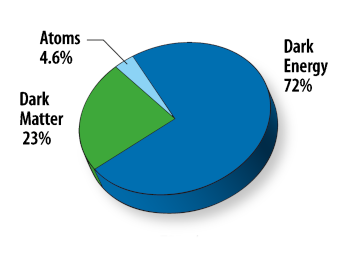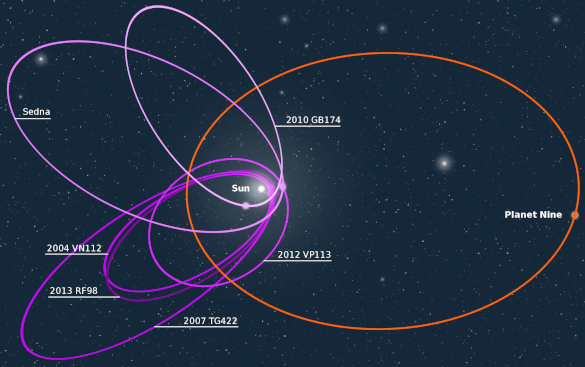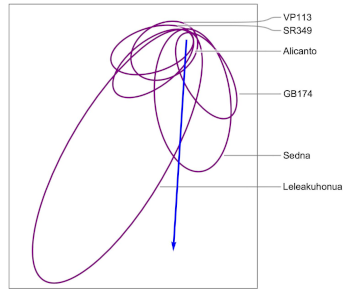MOND and Planet Nine
November 27, 2023
In writing these
blog articles, I provide
links to
keywords, most often to
Wikipedia, to give interested readers a way to better understand the topics. When I first started doing this, I found that I needed to be careful about such links, since the same
word can mean a different thing to different people. One easy example of this is
antenna, which is a device (
antenna) for
radio communications to
electrical engineers, but an
insect body part (
antenna) to a
biologist. To
Germans, Mond is the word for
Moon. To
physicists, MOND is the
acronym for
Modified Newtonian dynamics.
Newtonian gravitation quite
accurately defines the
gravitational attraction of
matter over an
interaction range from
laboratory scale (as in the
Cavendish experiment) to the
orbits of
planets in our
Solar System out to the farthest planet,
Neptune, at 30
astronomical units. That's a range of one
meter to 4.5 x 10
12 meters. Since gravitation is so weak, the
gravitational constant (6.67408±0.00031x10
-11 m
3 kg-1 s-2) is the least
precisely measured
physical constant, with a
relative uncertainty of 47
parts per million.[1]
In the
1970s,
Vera Rubin (1928-2016) and
Kent Ford (1931-2023) discovered that the
rotations of galaxies would only conform to Newtonian gravitation is they contained about six times as much
dark mass as
visible mass. This led to the
theory that
dark matter is the principal constituent of matter in the
universe. To add to the
confusion, there's
dark energy, which is the dominant component of the universe, contributing about twice the total
energy of the universe as dark matter and ordinary matter combined.

Things were simpler in my childhood, when Pluto was still a planet, and the universe consisted of just ordinary matter.
Here's our present view of the constituents of the universe. The percentages don't add to 100 because of observational uncertainty.
(Portion of a Wikimedia Commons image by NASA/WMAP Science Team. Click for larger image.)
Theorizing the existence of dark matter was quite a leap of
faith. Another leap of faith that explains observations is the
idea that gravitation behaves differently at distances much larger than the scale of our Solar System. Our
Milky Way galaxy is about 87,500
light years in
diameter, which is much larger than the 0.00095 light years approximate diameter of Neptune's
orbit.
Modified Newtonian dynamics (MOND) describes how Newton's law of universal gravitation must be modified to account for gravitation at
galactic distance scales. So, which is the greatest leap of faith, dark matter, or MOND?
MOND was proposed in 1982, shortly after the discovery of the
anomalous gravitation of galaxies. MOND differs from Newtonian gravitation only at extremely small
gravitational accelerations, such as those arising from
forces between galaxies, which are far below anything encountered in the Solar System or in a laboratory. MOND has been modified over the decades as it's been tested by subsequent observations.
While gravitation is considered to be one of the
fundamental forces of nature, there's another theory of gravitation known as
entropic gravity that explains MOND. In entropic gravity, gravity is viewed as an
emergent phenomenon that arises from the
quantum entanglement of small
bits of
spacetime information. At a
threshold of gravitational acceleration of approximately 1.2x10
-10 m-sec
-2, gravitational strength starts to vary
inversely with distance, rather than the Newtonian
inverse square of distance. This threshold is just 12x10
-12 the strength of gravity at
Earth's surface.
Pluto, the former ninth planet, was demoted from planetary status in 2006, but a potential successor, called
Planet Nine, was
conjectured to exist in 2014, less than a
decade later.[2] I discussed Planet Nine in two previous articles (
Planet Nine, June 27, 2016 and
Farfarout, April 19, 2021). Planet Nine is proposed to be in a highly
elliptical orbit at a distance from the
Sun of about 40 billion to 140 billion
miles (400-1500 astronomical units).[2] Because of its distance and orbital
peculiarity, it's been proposed that Planet Nine is a captured
exoplanet.[3] Planet Nine has never been
imaged, but its mass is supposed to be ten times the
mass of the Earth.[3]

It's thought that the closely spaced orbits of the most distant objects discovered in the Kuiper Belt are a consequence of the gravity of Planet Nine. (Wikimedia Commons image by MagentaGreen. Click for larger image.)
While the mass of Planet Nine might be ten Earth masses, it might also be zero; that is, Planet Nine might not exist, observational evidence of its gravitational influence on other Kuiper Belt objects notwithstanding.[4] A recent
paper in
The Astronomical Journal by
Katherine Brown of
Hamilton College (Clinton, New York) and
Harsh Mathur of
Case Western Reserve University (Cleveland, Ohio) proposes that modified Newtonian dynamics (MOND) provides an alternative explanation for the anomalies in the orbits of the Kuiper Belt objects (KBOs) with
semimajor axes greater than 250 astronomical units.[5]

Orbits of six Kuiper Belt objects of the Sedna family projected onto the ecliptic plane. The major axes of the orbits are seen to align with the direction to the center of the galaxy, with the aphelion oriented towards the galactic center.
(Figure 3 of ref. 5, released under a Creative Commons license. Click for larger image.)
According to The Astronomical Journal paper, the orbits of these Solar System outliers should have high
eccentricity and a tendency for the
minor axes of their orbits to be
perpendicular to the direction to the center of the galaxy.[5] All of these features are exhibited in support of the MOND
hypothesis; so, MOND might be observable in the outer Solar System.[5] Says study
coauthor, Harsh Mathur,
"MOND is really good at explaining galactic-scale observations... but I hadn't expected that it would have noticeable effects on the outer Solar System... the alignment was striking."[6-7]
MOND appears to predict the observed
clustering of orbits. As a
mechanism, it's conjectured that the orbits of objects in the outer solar system would be dragged into alignment with the galaxy's own gravitational field over the course of
millions of years.[7] However, the
researchers note that the current
dataset is too small to draw reliable conclusions.[7-8]
References:
- Chao Xue, Jian-Ping Liu, Qing Li, Jun-Fei Wu, Shan-Qing Yang, Qi Liu, Cheng-Gang Shao, Liang-Cheng Tu, Zhong-Kun Hu, and Jun Luo, "Precision measurement of the Newtonian gravitational constant,"
National Science Review, vol. 7, no. 12 (December, 2020), pp. 1803-1817, https://doi.org/10.1093/nsr/nwaa165.
- Chadwick A. Trujillo and Scott S. Sheppard, "A Sedna-like body with a perihelion of 80 astronomical units," Nature, vol. 507, no. 7493 (March 27, 2014), pp. 471-474, doi:10.1038/nature13156.
- Alexander J. Mustill, Sean N. Raymond, and Melvyn B. Davies, "Is there an exoplanet in the Solar system?" MNRAS Letters, vol. 460, no. 1 (July 21, 2016), pp. L109-L113.
- Michael E. Brown and Konstantin Batygin, "The Orbit of Planet Nine," The Astronomical Journal, vol. 162, no. 5 (October 28, 2021), pp. 1-16, DOI 10.3847/1538-3881/ac2056. Also at arXiv.
- Katherine Brown and Harsh Mathur, "Modified Newtonian Dynamics as an Alternative to the Planet Nine Hypothesis," The Astronomical Journal, vol. 166, no. 4 (September 22, 2023), DOI 10.3847/1538-3881/acef1e. This is an open access paper with a PDF file here. Also at arXiv.
- Andrew Griffin, "'Planet Nine' hidden world at the edge of our solar system could actually be something else, scientists say," Independent (UK), October 6, 2023.
- Outer reaches of solar system could harbor another planet—or evidence modifying laws of gravity, Case Western Reserve University Press Release, October 5, 2023.
- Brown Publishes Study on MOND, Planet Nine Hypothesis, Hamilton College Press Release, September 28, 2023 .
Linked Keywords: Blog; hyperlink; link; index term; keyword; Wikipedia; word; antenna (radio); radio communications; electrical engineering; electrical engineer; insect; animal structure; body part; antenna (biology); biologist; Germans; Moon; physicist; acronym; Modified Newtonian dynamics; Newton's law of universal gravitation; Newtonian gravitation; accuracy and precision; accurately; gravitation; gravitational attraction; matter; fundamental interaction; distance; range; laboratory scale; Cavendish experiment; orbit; planet; Solar System; Neptune; astronomical unit; meter; gravitational constant; kilogram; kg; second; precisely; physical constant; measurement uncertainty; relative uncertainty; parts per million; 1970s; Vera Rubin (1928-2016); Kent Ford (1931-2023); galaxy rotation curve; rotations of galaxies; dark matter; dark mass; visible spectrum; visible; mass; scientific theory; universe; confusion; dark energy; energy; constituents of the universe; simplicity; simple; childhood; Pluto; planet; ordinary matter; percentage; observational uncertainty; Wikimedia Commons; NASA; Wilkinson Microwave Anisotropy Probe; WMAP Science Team; theory; theorizing; faith; idea; Milky Way galaxy; light year; diameter; orbit; Modified Newtonian dynamics (MOND); galaxy; galactic; anomaly; anomalous; gravitational acceleration; force; fundamental forces of nature; entropic gravity; emergence; emergent phenomenon; quantum entanglement; bit; spacetime; information; threshold model; threshold; multiplicative inverse; inversely; inverse-square law; lithosphere; Earth's surface; Planet Nine; conjecture; conjectured; decade; ellipse; elliptical; Sun; mile; unusual; peculiarity; extrasolar planet; exoplanet; digital imaging; imaged; Earth mass; mass of Earth; Planet Nine orbit; orbit; Kuiper Belt; gravitation; gravity; MagentaGreen; scientific journal; paper; The Astronomical Journal; Katherine Brown; Hamilton College (Clinton, New York); Harsh Mathur; Case Western Reserve University (Cleveland, Ohio); semimajor axes; Kuiper Belt object; Sedna; family; map projection; projected; plane of the Solar System; ecliptic plane; major axes; angle; align; direction (geometry); galactic center; center of the galaxy; aphelion; Creative Commons license; orbital eccentricity; minor axes; perpendicular; hypothesis; coauthor; cluster analysis; clustering; physics; mechanism; Mya; millions of years; research; researchers; dataset.